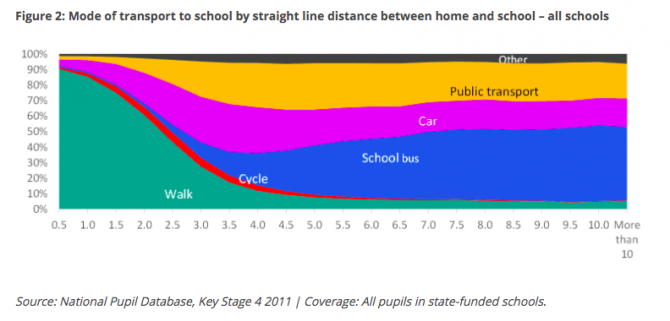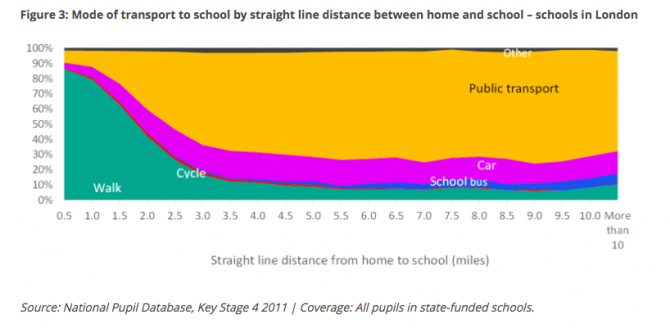There is currently “no credible solution” to the problem of year group bubbles mixing with other pupils while travelling to and from school, a think tank has said.
The Education Policy Institute warned today that a “significant number of pupils” are likely to mix with pupils from other year groups – and even other schools – during their journeys to and from school from September.
The government has said it is currently “evaluating” its position on home-to-school transport, following warnings that social distancing efforts could go out of the window when pupils are forced to cram onto buses again in September. Pupils have been urged to walk or cycle to school if they can, but many don’t have that option.
According to the EPI, around 1.1 million secondary school pupils in England rely either on a school bus or on public transport to get to and from school, and Jon Andrews, the think tank’s deputy head of research, said there were “no easy solutions” to the problem.
“Schools and local authorities will have to work together the best they can. But the government needs to be open about any assessment they have made of the risk that travelling to and from school poses,” he said.

Andrews’s analysis found that the vast majority of pupils who can walk to school already do so, and only a “very small proportion” of those within a reasonable walking distance from school are taking public transport or school buses.
“In other words, if pupils are on school buses, or on public transport, it is because they have no other option unless they have access to a private car.
“So while the government is telling schools to create bubbles of entire year groups within schools, there is currently no credible solution to the problem of them then mixing with other year groups, and other schools, on the bus home again. Parents of pupils with health conditions will have even more concerns in such a situation.”
The analysis found that key stage 4 pupils who travel several miles to school are more likely to rely on school buses than public transport.

But in London, public transport dominates, accounting for around 70 per cent of longer journeys.
Secondary schools typically attract pupils from up to three miles away, but in rural areas it can be significantly further.
And pupils attending special schools travel further still, typically around three times the distance for pupils in mainstream education. The EPI estimated in the past that in rural areas, 1 in 10 pupils in special schools travelled over 20 miles to get to school.
However, some of the data used in the analysis is almost 10 years old. The government ended the requirement for schools to provide information on travel in 2012.

The Department for Transport’s national travel survey estimates that 45 per cent of pupils either walk or cycle to school, and a further 35 per cent are taken by car – meaning that 1 in 5 pupils use either public transport or school buses. At secondary level this rises to 1 in 3 pupils – around 1.1 million.
In its guidance for reopening schools published yesterday, the DfE told schools to look for inspiration from the 2012 London Olympics for transport plans.
In his analysis, Andrews said “the situation we face today with an ongoing pandemic presents an assortment of very different challenges to those of eight years ago and many questions remain about the level of risk that school staff, pupils, and their families are being asked to take”.
The DfE has said that given the pressure on public transport, it may have to work with councils to put on additional dedicated school transport services, including areas in which they do not currently operate. But the government is currently only “evaluating” its position, and will set out the next steps “shortly”
The DfT is asking local authorities to work urgently with schools to survey parents on their typical routes to school and potential alternatives.
They are also asking them to consider a range of options for shifting demand for public transport on to other modes, and to consider using traffic demand management approaches in order to ensure that children are able to attend school from the start of the autumn term.
Pressed by Schools Week yesterday on why a proper plan wasn’t in place, education secretary Gavin Williamson said he would be working closely with councils in “making sure that depending on where we are in terms of dealing with this virus that the proper controls are properly in place on school transport”.








Secondary schools where I live look like Victoria coach station at end of school. Pupils also pile on public transport. This is repeated nationally outside cities and large towns. The gov’t says it’s urging LAs to negotiate with schools to survey parents. That’s not something that can be done in a few weeks, never mind putting plans in place ready for September.
This hasn’t been thought through by the government as usual. There are too many roadblocks to these approaches, not least the enforcement of attendance through fines. What will be next, imprisonment for caring parents fearing the disease? They need to work on making school environments and the journey to get there, genuinely safer, and drop the bully-boy tactics. They have a few weeks to earn the huge salaries they are paid and get this working properly if they, the government (not the teachers, not the parents, not the pupils) are to avoid the blame for a second, third or fourth spike of this virus being transmitted through forced school attendances for all pupils in large groups, euphemistically known as “bubbles”. They, the government, have the means to put plans and infrastructure in place. No one else can control these things. It is their job to make sure they have proper safeguards in place for all pupils and staff such as distancing controls, PPE for all staff, and screens to protect students, if they want schools to operate at normal capacity.
It astounds me that they still think bashing away at the impossible will solve this! It will take a lot of time, money, practical work to adjust the physical conditions in classrooms, cooperation and understanding between the government and parents, staff and pupils, including reassuring the teachers’ unions plus those of other school staff, and parents alike, that all possible means have been employed. Whilst schools still have no protections for any of these groups, and government are now abolishing the only protection left, the 2-metre distancing rule (both on transport and in the classroom) in order to save face, there will be resistance. They had better expect it.
Many children have no option but to use public transport and in my local area buses are always packed with children and parents at school times. This will increase the risk is spreading coronavirus. For patents with underlying health condition this is very worrying. Yet the government appear to be focusing on the risk to children of returning to school and are ignoring the risk to other people who are vulnerable to Covid-19
I am a retired teacher with around 40 years experience of teaching in Primary, Middle and Secondary schools in addition to leadership and management roles and working as a Local Authority Adviser in the latter years.
I waited with anticipation for a Department for Education school strategy underpinned by supportive guidance and related resources. I would have expected schools to be prioritised early on in March to avoid the 5+ months that the majority of children, who have been at home following lessons sent out by schools, online lessons, purchased books and parents struggling to work from home while providing supervision and support, would have had to endure.
The ‘strategy’ delivered by the Secretary of State for Education, in the House of Commons was little more than advising that all children would be back in school in September along with guidance that would be impossible to follow.
The guidance states that returning to school is vital for children’s education and well-being sooner rather than later and the importance of continuing to deliver a broad and balanced curriculum. Who would argue with that?
It also talks about changed circumstances and the decreased prevalence of COVID-19, however this does not in any way mean that we are free from this virus. The scientists believe we are on ‘a knife’s edge’, June 1st was too soon to reopen further and reopening was not without risks. The test, track, trace and isolate systems are up and running but far from adequate or satisfactory. There are concerns regarding spikes in towns and cities, further local lockdowns on the horizon and the significant possibility of a second wave. At this stage the virus has decreased but not to the level where measures should be relaxed to the extent schools are expected to respond, in fact we have reached a plateau which seems to show little decrease in infections and a continued worrying and devastating death rate. A lack of transparency in sharing up-to-date data has resulted in the inability to make informed decisions at local level.
Schools have remained open and initially able to cater for the children of frontline workers and vulnerable children, many of whom have not attended when the latter group should have been a real focus at the outset. As a result their journey will see a formidable ‘mountain to climb’ for them and schools.
Further year groups were invited to attend on 1st June against the advice of scientists with schools working hard, and in some cases struggling, to address the space, capacity and resources required in their schools to address issues raised in risk assessments.
The return of the whole school population in September will create unimaginable problems that will not be addressed without a strategy. The guidance states that, ‘the risk to children is very low’ but fails to consider staff, parents, carers, wider family members and the wider community in terms of the potential risks of children who are asymptomatic or pre-symptomatic, in addition to those who display symptoms while in school. This has the potential to see many households at risk. (In Florida more than 7000 children have tested positive for COVID-19.)
Schools were not built to cater for COVID-19 and are already a haven for bugs and viruses which flourish particularly in the winter months. The guidance states that schools do not need to create further capacity yet need prevention measures. I’m struggling to see how any prevention measures will be implemented when schools are and will be the same places now as before this virus arrived.
If children are to go back in September, with all stakeholders consulted and confident that ‘no stone has been left unturned’ to ensure the safety of schools and their communities with risks mitigated, then a strategy for their return needs to be put in place now. This should address appropriate testing, the need for greater space and how that can be achieved, increased workforce capacity with additional resources and equipment, consideration of extending washing and toilet facilities, PPE and related sanitising items for the school community and work spaces; this is not an exhaustive list. Possibly a school day of 24 hours because that’s the amount of time needed to keep the environment, resources and equipment clean in addition to delivering the broad and balanced curriculum!!!
Schools have been working with minimal resources and funding for a number of years now and it needs to change if this return is to be safe and ultimately successful and if the Government is truly concerned for the children to receive the education they are entitled to. However, this needs to be done with the safety and well-being of all members of the school community and it’s wider community at the forefront of any strategy, guidance and resources.
If the Government fails to address these issues then the return will not be successful because, irrespective of any fines, parents will not risk their family’s health and safety and I wouldn’t blame them. It’s a matter of trust which is currently low and will not improve if the Government continues along this narrow path.
On a personal note I would feel safer going into a pub with the risk assessments they have carried out than spend the day in a school full to capacity with between 400 and 1000+ pupils/students and I won’t be going to a pub any time soon!